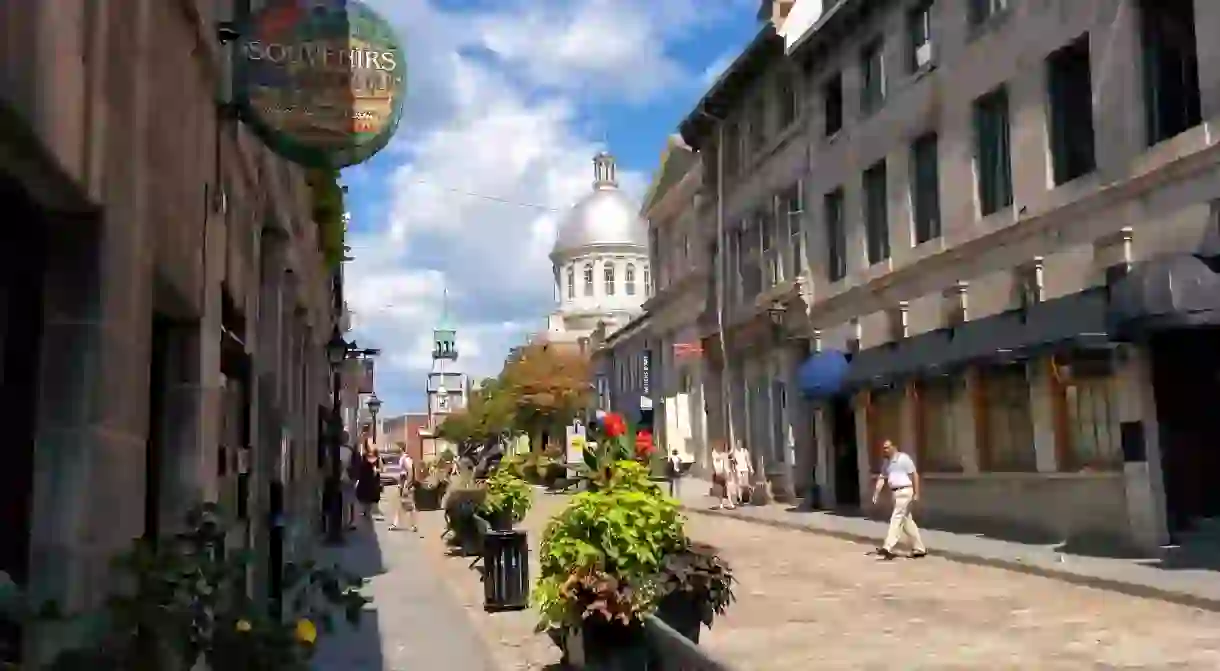A Perfect Walking Tour of Montreal, Canada

Despite being one of the major cities in Canada, Montreal is relatively small and quite easy to navigate on foot (or by bike). Several of its best-known and most vibrant districts are within a stone’s throw of each other, which is ideal for exploring. Here are our recommendations for planning out a perfect self-guided walking tour of Montreal.
Notre Dame Basilica
Start in the heart of Montreal’s historic district, in front of one of its most iconic buildings. Notre Dame is a Gothic Revival basilica whose foundations date back to 1672, with the region’s French Catholic origins. With intricate carvings, statues, and richly colored stained-glass windows, the basilica is impressive to take in both inside and out.

Old Montreal & the St. Lawrence River
From the Basilica, start walking east to continue exploring the cobblestone streets of Old Montreal. Make sure to stop by the Palais de justice, Place Jacques Cartier, and the Hôtel de ville. All three are significant historical landmarks that reflect the city’s colonial history. Other places to visit along the way include the Clock Tower, with its beautiful views of the Old Port and the St. Lawrence River, as well as the Pointe-à-Callière museum, which houses important local archaeological ruins. You can stop for a bite to eat at the Marché Bonsecours.

Chinatown
Heading away from the Old Port, walk through Montreal’s Chinatown neighborhood, which is marked by an ornate paifang, or arched gateway, on Boulevard Saint Laurent. Here, you’ll find a variety of Asian markets, shops, bakeries, and restaurants.

Quartier des Spectacles
From there, walk over to Quartier des Spectacles, which will also give you a sense of the downtown area of Montreal. Quartier des Spectacles is the city’s main arts and entertainment district, which hosts popular annual festivals such as Montreal’s Jazz Festival, Just for Laughs, and other events. If you visit Montreal during the warmer months—and even during the icy depths of winter, around the holidays—you’re sure to come across a lively free event in the central Place des Festivals.

Boulevard Saint Laurent & the Plateau
From Quartier des Spectacles, meander up Boulevard Saint Laurent, which is one of the main east-west arteries in the city. This route will take you up into the Plateau neighborhood, a popular spot for students, hipsters, and visitors. Here, you’ll find boutiques, cafés, clubs, and restaurants, along with some of the important landmarks in Montreal’s street art scene. Explore some of the side streets to get a sense of the architectural and cultural elements that make this area unique.

Parc Mont-Royal
You can also walk over to the central “mountain” that gives Montreal its name. Rising at its highest peak to 233 meters (764 feet), Mont-Royal is home to a sloping park and forested pathways that make it a popular spot for joggers, cyclists, picnickers, and during the winter, even cross-country skiers. It’s a large park with different levels, including various lookouts that offer great views of the city skyline, a human-made pond, trails, and green fields.

The Mile End
If you keep walking up St. Laurent, you’ll find yourself heading out of the Plateau and into the Mile End. As the Plateau continues to gentrify, the Mile End has captured some its artistic and hipster elements. Here, you’ll find iconic Montreal bagel spots Fairmount and Saint-Viateur, along with Café Olympico and other restaurants and coffee shops. There are also a variety of boutiques and galleries to explore in this neighborhood.
Little Italy
Past the Mile End, you’ll find Little Italy, with its origins reaching back even prior to the major wave of Italian immigration to Montreal (and other Canadian cities) between 1946 and 1960. There are Italian-Canadian restaurants, cafés, bars, and shops, and the neighborhood has a friendly and ambient atmosphere. You can also visit the Church of the Madonna della Difesa, built by Italian immigrants and inaugurated in 1919. It’s celebrated for its beautifully painted cupola and ceiling frescoes.

Jean-Talon Market
End this walking tour of some of Montreal’s most iconic areas with a visit to the Jean-Talon Market, one of the city’s finest. Open year-round, at Jean-Talon, you can find a variety of local produce, meat, cheese, fish, spices, and baked goods. There are around 300 vendors, so you’re sure to find something to enjoy—whether it’s a smoothie, snack or light meal—while people-watching in the lively market. It’s a perfect way to end a long day of walking and exploring the city.














